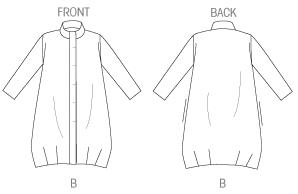The editor provided one interesting difference between art and craft that carries no stigma - craft is more often associated with usefulness whereas art is ... well, I don't know ... what is art?
I won't settle that question, but I will put forward as a candidate for both art and (fine) craft these sleeves designed by Diane Ericson in her Fault Lines pattern. They are brilliantly designed so as to capture the 3D aspect of a garment, as well as the expected softness.
Aren't they just lovely? And look at how they hang once inserted into the armscye:
A well designed sleeve will sometimes have an elbow dart. See how that dart is artfully integrated into the seam that wraps from back towards the front? Just brilliant.
I must admit that I was dubious about the instructions. And intimidated. It's only fabric so I let go and followed them, but set the stitch length just a little longer than usual. And I was glad I did, because my first try failed ... not because the instructions were wrong. No, I second-guessed Diane and went my own way and learned my own way. rip, rip, rip.
Diane's instructions for the construction of this sleeve are spot-on. And a wonderful little puzzle.
In the picture below you can see how the front piece (the longer of the two) gets wrapped around the finished corner of the back piece.
And here is how it looks before the lining is attached. You can see how the wrapping causes the seam to be pressed towards the front (the longer portion of the cuff).
The fabric is a medium weight linen which is just a dream to sew.
I will look forward to making this sleeve again now. I hope you will too!




















